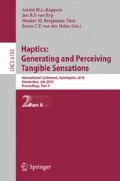Abstract
In a recent study, Cardinali et al. (2009) showed that training the use of a tool affected kinematic characteristics of subsequent free movements (i.e., movement were slower, for instance), which they interpreted as that the use of a tool affects the body schema. The current study examined whether these results can also be explained in terms of motor learning where movement characteristics during tool use persist in the free movements. Using a different tool we replicated parts of the study of Cardinali et al: As did Cardinali et al. we found that tool use after-effects can be found in subsequent free movements. Importantly, we showed that the tooling movement was very slow compared to the free hand movement. We concluded that it can not be ruled out yet that after-effects of tool use originate from a general slowing down of movement speed that persists in free hand movements.
Access this chapter
Tax calculation will be finalised at checkout
Purchases are for personal use only
Preview
Unable to display preview. Download preview PDF.
References
Berlucchi, G., Aglioti, S.M.: The body in the brain revisited. Exp. Brain. Res. 200, 25–35 (2010)
Cardinali, L., Frassinetti, F., Brozzoli, C., Urquizar, C., Roy, A.C., Farn, A.: Tool-use induces morphological updating of the body schema. Curr. Biol. 19, 478–479 (2009)
Gentilucci, M., Roy, A.C., Stefanini, S.: Grasping an object naturally or with a tool: are these tasks guided by a common motor representation. Exp. Brain. Res. 157, 496–506 (2004)
Iriki, A., Tanaka, M., Iwamura, Y.: Coding of modified body schema during tool use by macaque postcentral neurones. Brain 7, 2325–2330 (1996)
Author information
Authors and Affiliations
Editor information
Editors and Affiliations
Rights and permissions
Copyright information
© 2010 Springer-Verlag Berlin Heidelberg
About this paper
Cite this paper
Bongers, R.M. (2010). Do Changes in Movements after Tool Use Depend on Body Schema or Motor Learning?. In: Kappers, A.M.L., van Erp, J.B.F., Bergmann Tiest, W.M., van der Helm, F.C.T. (eds) Haptics: Generating and Perceiving Tangible Sensations. EuroHaptics 2010. Lecture Notes in Computer Science, vol 6192. Springer, Berlin, Heidelberg. https://doi.org/10.1007/978-3-642-14075-4_39
Download citation
DOI: https://doi.org/10.1007/978-3-642-14075-4_39
Publisher Name: Springer, Berlin, Heidelberg
Print ISBN: 978-3-642-14074-7
Online ISBN: 978-3-642-14075-4
eBook Packages: Computer ScienceComputer Science (R0)

